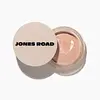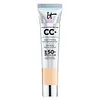What's inside
What's inside
 Key Ingredients
Key Ingredients

 Benefits
Benefits

 Concerns
Concerns

 Ingredients Side-by-side
Ingredients Side-by-side

Water
Skin ConditioningCaprylic/Capric Triglyceride
MaskingC12-15 Alkyl Benzoate
AntimicrobialCaprylic/Capric/Succinic Triglyceride
EmollientPropanediol
SolventSimmondsia Chinensis Seed Oil
EmollientOlea Europaea Fruit Oil
MaskingCoco-Caprylate/Caprate
EmollientDiisostearyl Malate
EmollientC9-12 Alkane
SolventPolyhydroxystearic Acid
EmulsifyingHydrogenated Castor Oil
EmollientRicinus Communis Seed Oil
MaskingHelianthus Annuus Seed Wax
Skin ConditioningStearalkonium Hectorite
Gel FormingEuphorbia Cerifera Wax
Polyglyceryl-3 Diisostearate
EmulsifyingPolyglyceryl-3 Polyricinoleate
EmulsifyingPhenoxyethanol
PreservativeCopernicia Cerifera Wax
Silica Silylate
EmollientSodium Chloride
MaskingPelargonium Graveolens Oil
MaskingTocopheryl Acetate
AntioxidantPolyglyceryl-6 Polyricinoleate
EmulsifyingTriethoxycaprylylsilane
Zingiber Officinale Root Oil
MaskingLecithin
EmollientSilica
AbrasiveBiosaccharide Gum-1
HumectantSodium Hyaluronate
HumectantMica
Cosmetic ColorantCI 77891
Cosmetic ColorantIron Oxides
Citronellol
PerfumingGeraniol
PerfumingLinalool
PerfumingLimonene
PerfumingCitral
PerfumingWater, Caprylic/Capric Triglyceride, C12-15 Alkyl Benzoate, Caprylic/Capric/Succinic Triglyceride, Propanediol, Simmondsia Chinensis Seed Oil, Olea Europaea Fruit Oil, Coco-Caprylate/Caprate, Diisostearyl Malate, C9-12 Alkane, Polyhydroxystearic Acid, Hydrogenated Castor Oil, Ricinus Communis Seed Oil, Helianthus Annuus Seed Wax, Stearalkonium Hectorite, Euphorbia Cerifera Wax, Polyglyceryl-3 Diisostearate, Polyglyceryl-3 Polyricinoleate, Phenoxyethanol, Copernicia Cerifera Wax, Silica Silylate, Sodium Chloride, Pelargonium Graveolens Oil, Tocopheryl Acetate, Polyglyceryl-6 Polyricinoleate, Triethoxycaprylylsilane, Zingiber Officinale Root Oil, Lecithin, Silica, Biosaccharide Gum-1, Sodium Hyaluronate, Mica, CI 77891, Iron Oxides, Citronellol, Geraniol, Linalool, Limonene, Citral
Titanium Dioxide 9%
Cosmetic ColorantZinc Oxide 6.3%
Cosmetic ColorantWater
Skin ConditioningPhenyl Trimethicone
Skin ConditioningDimethicone
EmollientButylene Glycol
HumectantButylene Glycol Dicaprylate/Dicaprate
EmollientOrbignya Oleifera Seed Oil
EmollientButyloctyl Salicylate
Skin ConditioningCetyl PEG/PPG-10/1 Dimethicone
EmulsifyingCyclopentasiloxane
EmollientSnail Secretion Filtrate
Skin ConditioningAluminum Hydroxide
EmollientMagnesium Sulfate
Polyglyceryl-4 Isostearate
EmulsifyingStearic Acid
CleansingCyclohexasiloxane
EmollientDimethicone/Vinyl Dimethicone Crosspolymer
Skin ConditioningHexyl Laurate
EmollientCalcium Stearate
Cosmetic ColorantTriethoxycaprylylsilane
Caprylyl Glycol
EmollientEthyl Hexanediol
SolventEthylhexylglycerin
Skin ConditioningLimonene
PerfumingCitrus Limon Peel Oil
MaskingSorbitan Isostearate
EmulsifyingTocopheryl Acetate
AntioxidantPhenoxyethanol
PreservativeCitrus Aurantium Bergamia Fruit Oil
Masking1,2-Hexanediol
Skin ConditioningAdenosine
Skin ConditioningCitrus Aurantium Dulcis Peel Oil
MaskingCitrus Aurantifolia Oil
CleansingPinus Sylvestris Leaf Oil
MaskingLinalool
PerfumingEucalyptus Globulus Leaf Oil
PerfumingGlycerin
HumectantCitral
PerfumingNiacinamide
SmoothingHyaluronic Acid
HumectantColloidal Oatmeal
AbsorbentHydrolyzed Collagen
EmollientSteareth-20
CleansingPentaerythrityl Tetra-Di-T-Butyl Hydroxyhydrocinnamate
AntioxidantCamellia Sinensis Leaf Extract
AntimicrobialOlea Europaea Leaf Extract
PerfumingChlorhexidine Digluconate
AntimicrobialN-Hydroxysuccinimide
Skin ConditioningSilk Extract
Skin ConditioningHydrolyzed Silk
HumectantSodium Citrate
BufferingPotassium Sorbate
PreservativePalmitoyl Tripeptide-1
Skin ConditioningChrysin
Skin ConditioningPalmitoyl Tetrapeptide-7
Skin ConditioningCitric Acid
BufferingBiotin
AntiseborrhoeicTitanium Dioxide 9%, Zinc Oxide 6.3%, Water, Phenyl Trimethicone, Dimethicone, Butylene Glycol, Butylene Glycol Dicaprylate/Dicaprate, Orbignya Oleifera Seed Oil, Butyloctyl Salicylate, Cetyl PEG/PPG-10/1 Dimethicone, Cyclopentasiloxane, Snail Secretion Filtrate, Aluminum Hydroxide, Magnesium Sulfate, Polyglyceryl-4 Isostearate, Stearic Acid, Cyclohexasiloxane, Dimethicone/Vinyl Dimethicone Crosspolymer, Hexyl Laurate, Calcium Stearate, Triethoxycaprylylsilane, Caprylyl Glycol, Ethyl Hexanediol, Ethylhexylglycerin, Limonene, Citrus Limon Peel Oil, Sorbitan Isostearate, Tocopheryl Acetate, Phenoxyethanol, Citrus Aurantium Bergamia Fruit Oil, 1,2-Hexanediol, Adenosine, Citrus Aurantium Dulcis Peel Oil, Citrus Aurantifolia Oil, Pinus Sylvestris Leaf Oil, Linalool, Eucalyptus Globulus Leaf Oil, Glycerin, Citral, Niacinamide, Hyaluronic Acid, Colloidal Oatmeal, Hydrolyzed Collagen, Steareth-20, Pentaerythrityl Tetra-Di-T-Butyl Hydroxyhydrocinnamate, Camellia Sinensis Leaf Extract, Olea Europaea Leaf Extract, Chlorhexidine Digluconate, N-Hydroxysuccinimide, Silk Extract, Hydrolyzed Silk, Sodium Citrate, Potassium Sorbate, Palmitoyl Tripeptide-1, Chrysin, Palmitoyl Tetrapeptide-7, Citric Acid, Biotin
 Reviews
Reviews

Ingredients Explained
These ingredients are found in both products.
Ingredients higher up in an ingredient list are typically present in a larger amount.
Citral is a fragrance and used to add a lemon-like scent to products. It is both naturally found in plants and created synthetically. In plants, it is commonly occurring in lemon myrtle, lemongrass, lemon tea-tree, lemon verbena, and other citruses.
The EU mandates Citral be listed separately as a fragrance. It is a known allergen and may cause contact dermatitis. Citral can also used as a masking ingredient.
The term 'fragrance' is not regulated in many countries. In many cases, it is up to the brand to define this term. For instance, many brands choose to label themselves as "fragrance-free" because they are not using synthetic fragrances. However, their products may still contain ingredients such as essential oils that are considered a fragrance.
The term 'citral' is a collective term for two geometric isomers: geranial/Citral A and neral/Citral B.
Learn more about CitralLimonene is a fragrance that adds scent and taste to a formulation.
It's found in the peel oil of citrus fruits and other plants such as lavender and eucalyptus. The scent of limonene is generally described as "sweet citrus".
Limonene acts as an antioxidant, meaning it helps neutralize free radicals.
When exposed to air, oxidized limonene may sensitize the skin. Because of this, limonene is often avoided by people with sensitive skin.
The term 'fragrance' is not regulated in many countries. In many cases, it is up to the brand to define this term. For instance, many brands choose to label themselves as "fragrance-free" because they are not using synthetic fragrances. However, their products may still contain ingredients such as essential oils that are considered a fragrance.
Learn more about LimoneneLinalool is a fragrance and helps add scent to products. It's derived from common plants such as cinnamon, mint, citrus, and lavender.
Like Limonene, this ingredient oxidizes when exposed to air. Oxidized linalool can cause allergies and skin sensitivity.
This ingredient has a scent that is floral, spicy tropical, and citrus-like.
Learn more about LinaloolPhenoxyethanol is a preservative that has germicide, antimicrobial, and aromatic properties. Studies show that phenoxyethanol can prevent microbial growth. By itself, it has a scent that is similar to that of a rose.
It's often used in formulations along with Caprylyl Glycol to preserve the shelf life of products.
Tocopheryl Acetate is AKA Vitamin E. It is an antioxidant and protects your skin from free radicals. Free radicals damage the skin by breaking down collagen.
One study found using Tocopheryl Acetate with Vitamin C decreased the number of sunburned cells.
Tocopheryl Acetate is commonly found in both skincare and dietary supplements.
Learn more about Tocopheryl AcetateTriethoxycaprylylsilane is a silicone used to bind and stabilize ingredients.
As an emulsifier, it helps prevent ingredients from separating. This can help elongate the shelf life of products.
Triethoxycaprylylsilane is often used to coat mineral sunscreens ingredients to help give a better feel. It also helps reduce oxidative stress in sunscreens.
Learn more about TriethoxycaprylylsilaneWater. It's the most common cosmetic ingredient of all. You'll usually see it at the top of ingredient lists, meaning that it makes up the largest part of the product.
So why is it so popular? Water most often acts as a solvent - this means that it helps dissolve other ingredients into the formulation.
You'll also recognize water as that liquid we all need to stay alive. If you see this, drink a glass of water. Stay hydrated!
Learn more about Water